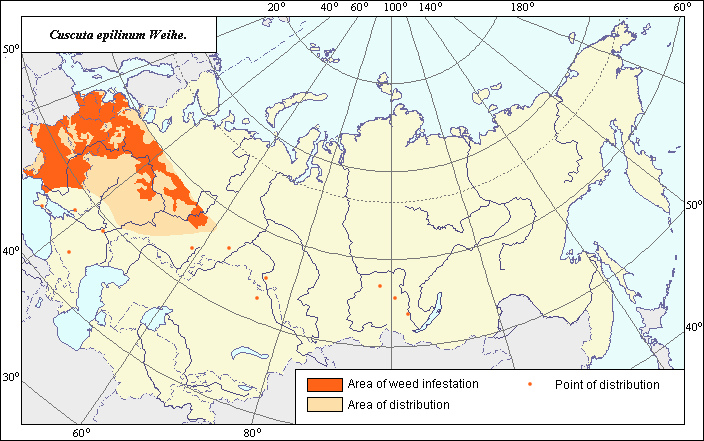Weeds
Area of distribution and weediness of Cuscuta epilinum Weihe.
 Object description Download GIS-layers
Object description Download GIS-layers
Authors:
Biologist specialist - S.Yu.Larina,GIS-specialist - I.A.Budrevskaya.
Date of creation:
08.12.2006.Scale:
1:20 000 000.Accuracy of the map:
It is created on materials of maps of natural scale 1:5 000 000 - 1:100 000 000.Projection:
"Alber's Equal Area Conic for the USSR", 9, 1001, 7, 100, 0, 44, 68, 0, 0.Basic content:
Vector map. Area of distribution is shown by polygon (main distribution) and by dots (sporadic distribution). Zone of weediness is shown by polygon.Accuracy of the classifier:
Within the area of C. epilinum, the zones of its weediness are shown, established by criteria of occurence (% of fields where this species is found) and abundance (expressed as projective cover of this species in the field (in % to the field area)) (Tanskii et al., 1998), i.e.; where the occurence of this species exceeded 20% with its abundance (projective cover) more than 15%.Method of map production:
The areas of distribution and weediness of C. epilinum are established according to the analysis of the open published maps and literature. The area of distribution is based on publications of A.N.Volkov (1935) and E.Hulten & M.Fries (1986). Northern limit of the area is established according to A.N.Volkov (1935), which is supported by the data of G.P.Moskalenko (2001). The zones of weediness of C. epilinum are established according to V.V.Nikitin (1983), with specification by V.Ya.Maryushkina et al. (1990) and G.P.Moskalenko (2001), being coordinated with the limits of arable lands. The sites of sporadic distribution of C. epilinum within the European part of the Former Soviet Union are shown according to E.Hulten & M.Fries (1986), in the Caucasus they are depicted by A.A.Grossgeim (1950), within Siberia by E.Hulten & M.Fries (1986) and A.N.Volkov (1935).Reference citations:
Grossgeim A.A. 1967. Flora of the Caucasus. V.7. Moscow-Leningrad: AN SSSR. 895 p. (in Russian).Hulten E. & Fries, M. 1986. Atlas of North European Vascular Plants, North of the Tropic of Cancer: Konigstein, V. 1-3: 1172 p.
Keller B.A., ed. 1934. Weed plants of the USSR. V.3. Leningrad: AN SSSR. 448 p. (in Russian).
Maryushkina V.Ya., Didyk L.G., Kozeko V.G. & Kayutkina T.M. 1990. Manual on quarantine weeds. Kiev: Urozhai. 96 p. (in Russian).
Melnichuk O.S. & Kovalivska G.M. 1972. Atlas of the most widespread weeds of the Ukraine. Kiev: Urozhai, p. 27-28 (in Ukrainian).
Moskalenko G.P. 2001. Quarantine weeds of Russia. Moscow: Rosgoskarantin. 280 pp. (in Russian).
Nikitin V.V. 1983. Weed plants of the USSR flora. Leningrad: Nauka. 454 p. (in Russian).
Shishkin B.K., eds. 1953. Flora of the USSR. V.19. Moscow-Leningrad: AN SSSR. 752 p. (in Russian).
Tanskii V.I., Levitin M.M., Ishkova T.I. & Kondratenko V.I. 1998. Phytosanitary diagnostics in integrated management of cereals. In: Novozhilov K.V., ed. Compendium of methodical recommendations in plant protection. Saint-Petersburg: VIZR. p. 5-55. (in Russian).
Volkov A.N., ed. 1935. Areas of distribution of the major weed plants in the USSR. Moscow-Leningrad: Publishing House of Kolchoz & Sovchoz Literature. 153 p. (in Russian).

